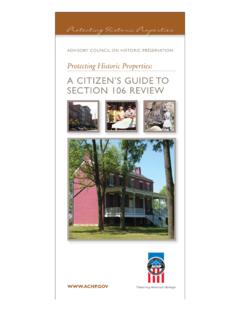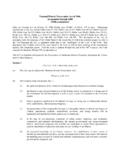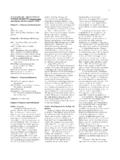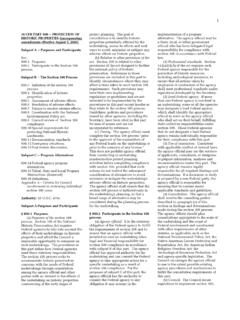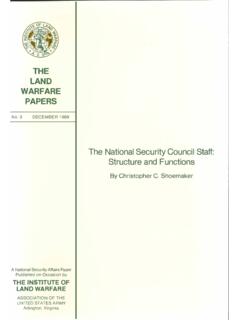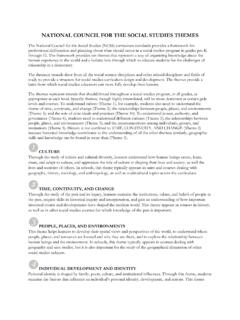Transcription of The National Historic Preservation Act
1 1 The National Historic Preservation Act As amended through December 16, 2016 and Codified in Title 54 of the United States Code [The Na tional Historic Preservation Act ( Act ) became law on October 15, 1966, Publ ic La w 89-665, a nd was co dified i n title 16 of the United States Code. Va rious amendments followed through the ye ars. On December 19, 2014, Publ ic La w 13-287 moved the Act s provisions from title 16 of the United States Code to title 54, wi th minimal and non-substantive changes to the te xt of the Act and a re-ordering of some of its provisions. This document s hows the provisions of the Act a s they now a ppear i n title 54 of the United States Code. The Act s name (the National Historic Pre serva tion Act ) i s found i n the notes of the ve ry fi rst section of ti tle 54.]
2 54 100101 note . While Public La w 13-287 di d not repeal the Act s findings, for editorial reasons those findings were not included in the te xt of ti tle 54. The findings a re still curre nt law. Howeve r, rather than citing to the Code, when re ferri ng to the findings one ma y ci te to: Section 1 of the National Historic Pre servation Act, Pub. L. No. 89-665, a s amended by Pub. L. No. 96-515. For e a se of use, this document re produces the te xt of those findings before proceeding to the title 54 te xt. Fi nally, the a ttachment at the e nd of this document a ttempts to assist those Preservation stakeholders who for ma ny ye ars h a ve re ferred to th e Act s va rious p ro visio ns acco rding to th e sectio n n umbers u sed in th e 1966 p u blic law an d su bsequen t a me ndments ( old s ections ).
3 The a ttachment cross-references e ach of the old sections to the corresponding outdated title 16 l e gal cite a nd current ti tle 54 l egal ci te.] Se ct ion 1 of the National Historic Preservation Act, Pub. L. No. 89-665, as amended by Pub. L. No. 96-515: .. (b) The Congress finds and declares that (1) the spirit and direction of the Nation are founded upon and reflected in its hi s tor ic her i ta ge; (2) the historical and cultural foundations of the Nation should be preserved as a living part of our community life and development in order to give a sense of orientation to the American peopl e; (3) Historic properties significant to the Nation's heritage are being l os t or s ubs ta nti a lly alter ed, often inadvertently, with increasing frequency.
4 (4) the Preservation of this irreplaceable heritage is in the public interest so that its vital legacy of cultural, educational, aesthetic, inspirational, economic, and energy benefits will be maintained and enriched for future generations of Amer i c a ns ; (5) i n the fa c e of ever-increasing extensions of urban centers, highways, and residential, commercial, and industrial developments, the present governmental and nongovernmental Historic Preservation programs and activities are inadequate to insure future generations a genuine opportunity to appreciate and enjoy the rich heritage of our Na ti on; (6) the increased knowledge of our Historic resources, the establishment of better means of identifying and administering them, and the enc our a gement of thei r pr es er va ti on will i mp r o ve the planning and execution of Federal and federally assisted projects and will assist economic growth and development.
5 And (7) although the major burdens of Historic Preservation have been borne and major efforts initiated by private agencies and individuals, and both should continue to play a vital role, it is never thel es s nec es s a r y a nd a ppr opr i a te for the Feder a l Gover nment to a c c el er a te i ts hi s tor i c pr es er vation programs and activities, to give maximum encouragement to agencies and individuals undertaking Preservation by private means, and to assist State and local gover nments 2 a nd the Na ti ona l Trus t for Hi s tori c Pres erva ti on in the United States to expand and accelerate their Historic Preservation programs and activities. Title 54 of the United States Code Subtitle III National Preservation Programs Division A Historic Preservation Subdivision 1 General Provisions Chapter 3001 Policy Sec.
6 300101. Policy 54 300101. Policy It is the policy of the Federal Government, in cooperation with other nations and in partnership with States, local governments, Indian tribes, Native Hawaiian organizations, and private organizations and individuals, to (1) use measures, including financial and technical assistance, to foster conditions under which our modern society and our Historic property can exist in productive harmony and fulfill the social, economic, and other requirements of present and future gener a ti ons ; (2) provide leadership in the Preservation of the Historic property of the United States and of the international community of nations and in the administration of the National Preservation program.
7 (3) a dmi ni s ter feder ally owned, administered, or controlled Historic property in a spirit of stewardship for the inspiration and benefit of present and future gener a ti ons ; (4) contribute to the Preservation of nonfederally owned Historic property and give maximum enc our a gement to organizations and individuals undertaking Preservation by private mea ns ; (5) encourage the public and private Preservation and utilization of all usable elements of the Nation s Historic built environment; and (6) assist State and local governments, Indian tribes and Native Hawaiian organizations, and the National Trust to expand and accelerate their Historic Preservation programs and a cti vities . Chapter 3003 Definitions Sec.
8 300301. Agency. 300302. Certified local government. 300303. Council. 300304. Cultural p ar k. 300305. Historic conservation district. 300306. Historic Preservation Fund. 300307. Historic Preservation review commission. 300308. Historic property. 300309. Indian tribe. 300310. Local government. 3 300311. National Register. 300312. National Trust. 300313. Native Hawaiian. 300314. Native Hawaiian organization. 300315. Preservation or Historic Preservation . 300316. Secretary. 300317. State. 300318. State Historic Preservation review board. 300319. Tribal land. 300320. Undertaking. 300321. World Heritage Convention. 300301. Agency In this division, the term agency has the meaning given the term in section 551 of title 5.
9 300302. Certified local government In this division, the term certified local government means a local government whose local Historic Preservation program is certified pursuant to chapter 3025 of this title. 300303. Council In this division, the term Council means the Advisory Council on Historic Preservation established by section 304101 of this title. 300304. Cultural park In this division, the term cultural park means a definable area that (A) is distinguished by Historic property, prehistoric property, and land related to that property; and (B) cons ti tutes an interpretive, educational, and recreational resource for the public at l a r ge. 300305. Historic conservation district In this division, the term Historic conservation district means an area that contains (1) Historic property; (2) buildings having similar or related architectural c ha ra cter i sti cs ; (3) cultural cohesiveness; or (4) any combination of features described in paragraphs (1) to (3).
10 300306. Historic Preservation Fund In this division, the term Historic Preservation Fund means the Historic Preservation Fund established under section 303101 of this title. 300307. Historic Preservation review commission In this division, the term Historic Preservation review commission means a board, council, commission, or other similar collegial body 4 (1) that is established by State or local legislation as provided in section 302503(a)(2) of this ti tl e; and (2) the members of which are appointed by the chief elected official of a jurisdiction (unless Sta te or local law provides for appointment by another official) from a mong (A) professionals in the disciplines of architecture, history, architectural history, planning, prehistoric and Historic archeology, folklore, cultural anthropology, curation, conservation, and landscape architecture, or related disciplines, to the extent that those professionals are available in the community; and (B) other individuals who have demonstrated special interest, experience, or knowledge in history, architecture, or related disciplines and will provide for an adequate and qualified c ommi s s i on.

